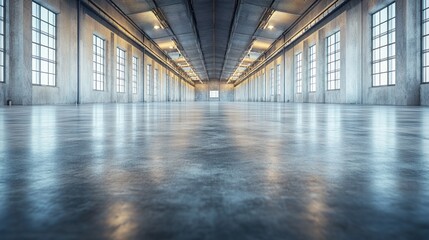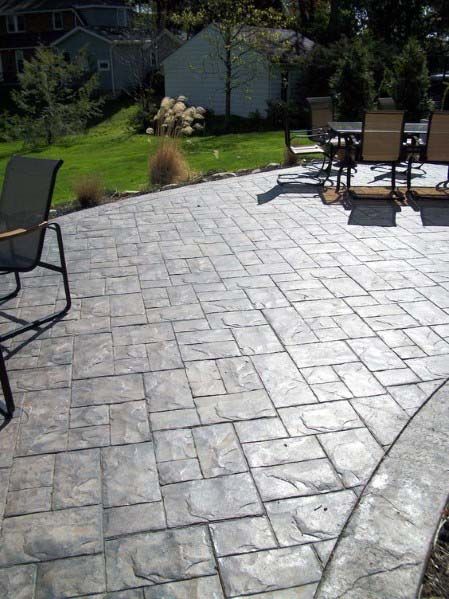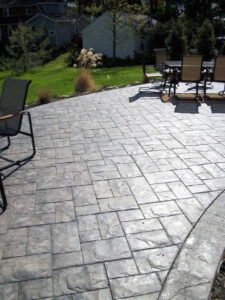Polished Concrete is an attractive and durable flooring option. It withstands heavy foot and machine traffic, lasts far longer than carpet, tiles or composites and is easily maintained with regular sweeping, dust removal and periodic mopping.
The proper concrete grinding and polishing process must be executed to achieve maximum clarity of reflection and durability. It must also be properly sealed to prevent staining.
Unlike many flooring materials, polished concrete is strong and durable, able to withstand heavy foot and machine traffic for years without damage. Its non-porous surface resists stains and is easy to clean, making it an ideal choice for industrial applications. The shine of polished concrete also enhances natural and artificial lighting, reducing energy costs.
A professional polished concrete finish and seal is almost impregnable to liquids, meaning that contaminants like dirt, oil, and chemicals can’t seep into the pores and cause damage. Additionally, the concrete’s high light reflectivity creates a brighter work environment.
In terms of aesthetics, polished concrete can be designed to fit any decor style, allowing you to customize the look to match your space. It can also be dyed and stained, though the range of options is limited compared to other flooring materials.
Durability is another benefit of polished concrete that’s often overlooked. It’s incredibly strong and resistant, easily able to handle the weight of cars, trucks, forklifts, stacked crates, and other equipment. In addition, it’s difficult to damage – high heels, furniture legs, and even pet claws can’t scratch the surface.
The durability of polished concrete is due in large part to the extensive grinding and etching that are done during the polishing process. This helps to remove any damaged or stained areas, as well as any existing coatings that are on the concrete. Additionally, the chemical densifier that is applied during the polishing process helps to harden and strengthen the concrete, making it more resistant to damage.
The concrete can then be sealed to protect the floor and ensure that it will last for years to come. This protection will help to reduce maintenance and repair costs, as well as minimizing the impact on the environment. The low environmental impact of polished concrete makes it an increasingly popular choice for homeowners and businesses looking for a sustainable option. It’s an excellent alternative to other expensive flooring materials such as wood, stone, and tile. While these other materials are great in their own right, they’re not as versatile or as cost-effective as polished concrete.
Aesthetics
Concrete is often associated with garages and basements, but its strength and durability make it a viable option for living spaces as well. Achieving the proper polishing process can give concrete floors a clean, refined look that complements many design styles. In addition, polished concrete is a great choice for retail settings because its high gloss makes products stand out and it can be customized to fit a brand’s image.
To achieve the right aesthetic, contractors use a multi-step process to refine concrete to meet specific appearance levels. This starts with stripping the existing coatings and repairing cracks and holes to expose the bare concrete surface. The floor is then cleaned to remove dirt, grease, and other debris that could interfere with the polishing process. After the concrete is cleaned, it is leveled to create a flat surface, and high spots are ground down or filled in.
During the grinding stage, the concrete is smoothed with mechanical tools to remove imperfections and achieve a desired smoothness. Once the concrete has been smoothed, it is prepared for the polishing stage, in which the concrete is finely ground to achieve the specified appearance level. This is done with hand-held machines or robotic polishers, and it can take up to four cycles of refining to reach the desired appearance level.
For the finishing touch, polished concrete can be stained or dyed in a wide variety of colors and patterns. This can add a pop of color that complements the surrounding décor, or it can be used to create a more subtle effect. In addition, the luster of polished concrete can be enhanced by adding wax to the surface.
In healthcare settings, the high light reflectivity of polished concrete helps to promote a clean, hygienic environment for patients and staff. Its durability and resistance to spills also help to reduce maintenance requirements, keeping operating costs low.
In commercial and industrial spaces, the durable surface of polished concrete can withstand heavy machinery and foot traffic, making it an ideal option for warehouses and manufacturing facilities. Its longevity and durability also make it an ideal choice for retail settings, where its high-gloss finish can showcase merchandise effectively. Its ease of cleaning also makes it a good choice for office spaces, where its professional look can impress clients and employees.
Low Maintenance
A polished concrete floor can be put into service immediately after the polishing process is completed. There are no waiting periods for the surface to cure or for adhesives to dry. Unlike most flooring materials, polished concrete is extremely durable and will hold up well to heavy foot traffic and equipment without the need for expensive coatings or repairs.
Regular cleaning with simple supplies and periodic re-polishing will keep your floor looking like new. Depending on your facility usage, you may only need to clean the surface twice or three times per year.
This durability and low maintenance cost is what makes Polished Concrete a great choice for commercial and industrial applications. It’s an ideal flooring solution for warehouses, manufacturing facilities, restaurants, office buildings, retail stores and automotive showrooms.
The concrete mix design can contain decorative aggregates to create a variety of aesthetic appearances. Typical aggregates are black basalt or brown river stone but almost any type of rock can be used. In addition to the standard concrete aggregate, colored glass and shells can be added to the mix for a unique terrazzo appearance.
Concrete is naturally porous which can cause problems with moisture and contaminates in the long term if not properly addressed. The polishing process densifies the concrete which creates a temporary barrier that helps to repel contaminants from penetrating the surface. This feature will reduce your maintenance costs significantly and will keep your floors looking their best for years to come.
With its natural look, high reflectivity and durability, polished concrete is a great choice for any space that requires a hard surface. It’s also very easy to keep sanitary as it doesn’t harbor bacteria and can be easily cleaned. However, the one drawback to the slick concrete is that it can be a little uncomfortable for people to walk on without shoes. This can be mitigated with the use of rugs or other acoustic absorption surface coverings. Similarly, the hardness of the surface can be a drawback in areas where machinery is used as it won’t cushion or absorb impact and vibrations.
Energy Efficiency
Concrete polishing transforms existing concrete surfaces into smooth and reflective floors that reflect light and enhance the appearance of interior spaces. With customization options to fit a variety of design aesthetics, polished concrete is an attractive flooring choice for many commercial and industrial applications. Its low maintenance requirements and long lifespan reduce costs for both materials and labor. In addition, the straightforward cleaning requirements of polished concrete align with sustainable hygiene practices, further lowering overall facility management expenses.
The durability of concrete means that it withstands heavy foot traffic and machinery movement, making it a suitable option for high-traffic areas. Its hard surface also resists abrasion and impact, helping to preserve the condition of the floor. Additionally, the durable finish and non-porous surface prevent stains from water, oil, and other contaminants, reducing the need for costly waxes and acidic scrubbing. This streamlined maintenance approach further cuts operational costs, delivering significant cost savings over other flooring options.
Energy Efficiency
The highly reflective surface of polished concrete helps to maximize natural light penetration, allowing businesses to maintain adequate illumination with less reliance on artificial lighting during daylight hours. This energy-saving feature can lead to substantial electricity savings.
Reduced Material Usage
Unlike epoxy, polished concrete does not require a separate coating and requires significantly less material to install. This can help reduce the environmental impacts associated with manufacturing and sourcing of new materials. In addition, the lack of VOCs in polished concrete can help improve indoor air quality compared to epoxy.
Long Lifespan
The durability of polished concrete enables it to withstand heavy foot traffic and machine movement for years to come, minimizing the need for frequent replacement. This longevity can help minimize waste and reduce the environmental impact associated with the manufacture, disposal, and recycling of replacement materials.
As a result, it’s no wonder that polished concrete is the preferred flooring solution for large retail stores, warehouses, car showrooms, hospitals, and other facilities that require a clean and safe environment. It’s the perfect flooring solution for Atlanta homes too, as it complements modern and minimalist designs while offering a sleek appearance for kitchens and basements. It’s even ideal for high-traffic garage floors in Atlanta’s humid climate, as it handles moisture and resists mold and mildew.


